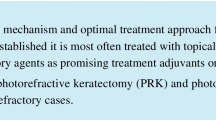Abstract
Purpose
To evaluate the efficacy of azithromycin hydrate ophthalmic solution for the treatment of internal hordeolum and meibomitis with or without phlyctenular keratitis.
Study Design
Retrospective study.
Methods
Patients diagnosed with internal hordeolum or meibomitis were prescribed azithromycin hydrate ophthalmic solution twice daily for 2 days and then once daily for 12 days. Depending on the presence of meibomitis-related keratoconjunctivitis (MRKC), we further divided the patients with meibomitis into three subgroups: meibomitis alone (non-MRKC group), meibomitis with non-phlyctenular MRKC (non-phlyctenular group), and meibomitis with phlyctenular MRKC (phlyctenular group). Inflammatory findings (eyelid redness and conjunctival hyperemia) were scored before and after treatment. Some patients also underwent culture testing fluids discharged by the meibomian gland orifices.
Results
Three patients (3 eyes) had internal hordeolum and 16 patients (16 eyes) had meibomitis. After treatment, the inflammatory findings disappeared in all eyes with internal hordeolum. Among the patients with meibomitis, three eyes were in the non-MRKC, six in the non-phlyctenular, and seven in the phlyctenular group. The inflammatory findings were significantly improved only in the phlyctenular group. Among seven eyes with positive culture results, Cutibacterium acnes was detected in five, and treatment improved the inflammatory findings in all of these eyes.
Conclusion
Azithromycin hydrate ophthalmic solution is effective for the treatment of inflammatory meibomian gland diseases, including internal hordeolum and meibomitis. In particular, the agent is highly efficient in patients with phlyctenular MRKC.
Similar content being viewed by others
Data Availability
All the data generated or analyzed during this study are included in this published article.
References
McCulley JP, Dougherty JM, Deneau DG. Classification of chronic blepharitis. Ophthalmology. 1982;89:1173–80.
Nichols KK, Foulks GN, Bron AJ, Glasgow BJ, Dogru M, Tsubota K, et al. The international workshop on meibomian gland dysfunction: Executive summary. Investig Ophthalmol Vis Sci. 2011;52:1922–9.
McCulley JP, Sciallis GF. Meibomian keratoconjunctivitis. Am J Ophthalmol. 1977;84:788–93.
Suzuki T. Inflamed obstructive meibomian gland dysfunction causes ocular surface inflammation. Investig Opthalmology Vis Sci. 2018;59:DES94.
Suzuki T, Teramukai S, Kinoshita S. Meibomian glands and ocular surface inflammation. Ocul Surf. 2015;13:133–49.
Akpek EK, Vittitow J, Verhoeven RS, Brubaker K, Amar T, Powell KD, et al. Ocular surface distribution and pharmacokinetics of a novel ophthalmic 1% azithromycin formulation. J Ocul Pharmacol Ther. 2009;25:433–9.
Luchs J. Azithromycin in durasite® for the treatment of blepharitis. Clin Ophthalmol. 2010;4:681–8.
Foulks GN, Borchman D, Yappert M, Kim S-H, McKay JW. Topical azithromycin therapy for Meibomian Gland Dysfunction: clinical response and lipid alterations. Cornea. 2010;29:781–8.
Arita R, Fukuoka S. Efficacy of azithromycin eyedrops for individuals with Meibomian Gland Dysfunction-Associated posterior blepharitis. Eye Contact Lens. 2021;47:54–9.
Nejima R, Eguchi H, Todokoro D, Inoue T, Kaji Y, Suzuki T, et al. Analysis of treatment protocols using azithromycin eye drops for bacterial blepharitis: second report—bacteriological investigation. Jpn J Ophthalmol. 2022;66:579–89.
Haque RM, Torkildsen GL, Brubaker K, Zink RC, Kowalski RP, Mah FS, et al. Multicenter open-label study evaluating the efficacy of azithromycin ophthalmic solution 1% on the signs and symptoms of subjects with blepharitis. Cornea. 2010;29:871–7.
Ciloglu E, Özcan AA, Incekalan T, Unal F. The role of topical azithromycin in the treatment of Meibomian Gland Dysfunction. Cornea. 2020;39:321–4.
Gordon AA, Danek DJ, Phelps PO. Common inflammatory and infectious conditions of the eyelid. DisMon. 2020;66:101042.
Japanese Association for Ocular Infection: Guidelines for the Clinical Trials of Topical Ophthalmic Antibacterial Agent. Ministry of Health, Labour and Welfare. (in Japanese). Accessed 18 Apr 2023.
Kagkelaris KA, Makri OE, Georgakopoulos CD, Panayiotakopoulos GD. An eye for azithromycin: review of the literature. Ther Adv Ophthalmol. 2018;10:251584141878362.
Azimycin ophthalmic solution 1%. Package insert. Senju Pharmaceutical Co., Ltd; 2020. (in Japanese).
Hirunwiwatkul P, Wachirasereechai K, Khantipong M, Chongthaleong A. Identifications of hordeolum pathogens and its susceptibility to antimicrobial agents in topical and oral medications. Asian Biomed. 2012;6:297–302.
Suzuki T, Sutani T, Nakai H, Shirahige K, Kinoshita S. The microbiome of the meibum and ocular surface in healthy subjects. Investig Ophthalmol Vis Sci. 2020;61:1–7.
Suzuki T, Sano Y, Sasaki O, Kinoshita S. Ocular surface inflammation induced by Propionibacterium acnes. Cornea. 2002;21:812–7.
Suzuki T. Meibomitis-Related keratoconjunctivitis: implications and clinical significance of meibomian gland inflammation. Cornea. 2012;31:41–4.
Acknowledgements
We thank Angela Morben, DVM, ELS, and J. Ludovic Croxford, PhD, from Edanz (https://jp.edanz.com/ac) for editing a draft of this manuscript.
Author information
Authors and Affiliations
Corresponding author
Ethics declarations
Conflict of interest
Y. Shimizu, None; K. Shinji, None; K. Mitoma, None; Y. Kiuchi, None; T. Chikama, None.
Additional information
Corresponding Author: Taiichiro Chikama
Publisher’s Note
Springer Nature remains neutral with regard to jurisdictional claims in published maps and institutional affiliations.
About this article
Cite this article
Shimizu, Y., Shinji, K., Mitoma, K. et al. Efficacy of azithromycin hydrate ophthalmic solution for treatment of internal hordeolum and meibomitis with or without phlyctenular keratitis. Jpn J Ophthalmol 67, 565–569 (2023). https://doi.org/10.1007/s10384-023-01010-w
Received:
Accepted:
Published:
Issue Date:
DOI: https://doi.org/10.1007/s10384-023-01010-w




